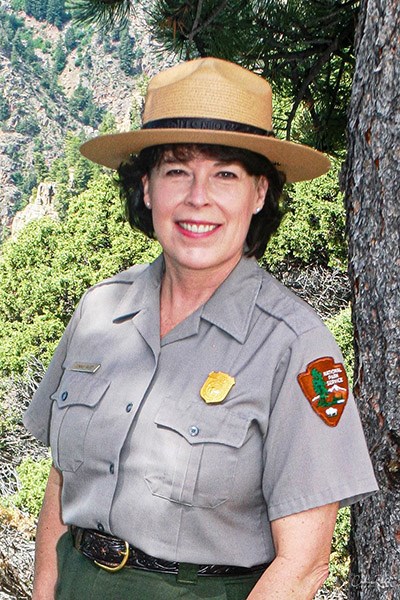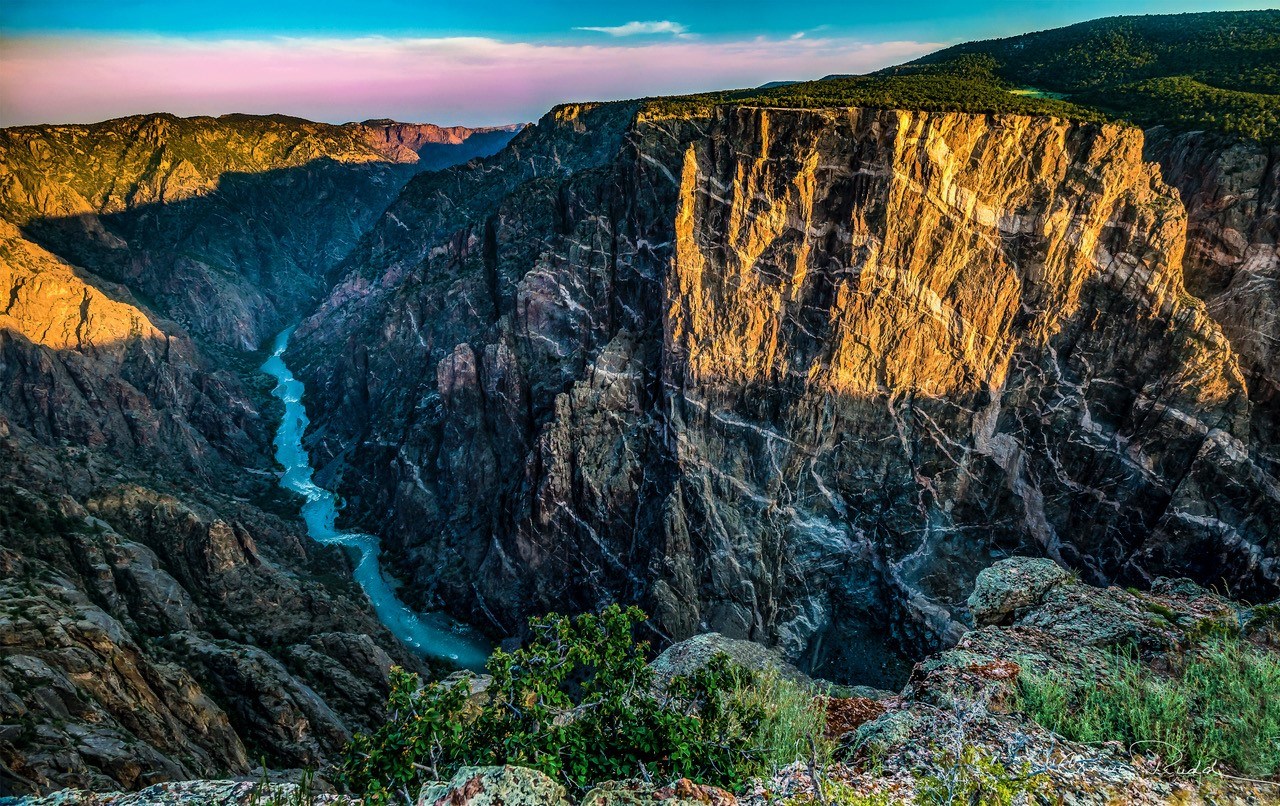Last updated: May 18, 2022
Article
Connie Rudd: Defining a Career Path
This article was developed from an oral history interview with Connie Rudd, conducted by Lu Ann Jones in June 2020 as part of the Women’s Voices: Women in the National Park Service Oral History Project. The Project was made possible in part by a grant from the National Park Foundation, and recordings will be archived at Harpers Ferry Center.

NPS
It could be said that Connie Lobdell Rudd lives by the mantra “open your eyes.” Her career with the National Park Service began in 1979 as a seasonal Park Ranger and led her to locations around the country until her retirement in 2014, in roles that included park ranger, planner at a regional support office, and park superintendent. Along the way, the continual desire to learn paired with her skillful communication have helped her define the course.
Early Years
Born in Fort Riley, Kansas, Rudd's connection to education began at an early age. Her mother was a high school English teacher and her father was a professor of history. Visits to national parks and historic sites were a part of her growing up. A 1960 visit to Mesa Verde National Park at the age of eleven set her life’s course:
RUDD: This was a world that was brand new to me. I never knew a thing about Pueblo Indians. I didn’t know about cliff dwellers. I was learning about the West. Of course, we went on a number of interpretive tours. A young seasonal ranger by the name of Dave Todd was our ranger to go down into one of the ruins, and I wish I could remember which one it was, but he was leading the group and he wanted to demonstrate how the women of that era ground corn, because the grinding pits were there and all of the original artifacts and so forth. He handed me a metate and showed me how to kneel down at the corn-grinding pit and put my feet against the brace at the back and then grind corn. He put some corn in the pit and I ground away, and it was magic. For a moment, I was transported back all of those years.
-
Connie Rudd: Early Visits to National Parks
In an oral history interview, Connie Rudd describes visits to national parks and historic sites as she was growing up.
- Credit / Author:
- NPS Park History Program
- Date created:
- 06/05/2020
NPS Beginnings and Grand Canyon National Park
After teaching high school students for five years, Rudd began her career with the National Park Service in a seasonal position as a dispatcher at Indiana Dunes National Lakeshore. As she witnessed the highly-developed interpretive program at that park, she came to understand what the education and interpretation programs at the National Park Service could be.
From there, she became a park ranger at Grand Canyon National Park. Rudd recognized the depth and complexity of topics associated with the Grand Canyon, and she found that her interpretive programs and contacts with visitors frequently led to questions that touched on policy and resource management.
Rudd addressed these questions by setting out to learn as much as she could, both on paper and in the field. At a time when the divisional lines of the agency tended to be well-defined, she worked to reach across those boundaries, modeling a practice that she would carry through her career.
RUDD: I think it was a time we were all evolving in much more interdisciplinary management of national parks. I didn’t know that’s what it was at the time. It was just I needed help to be as complete of an interpreter and public educator as I possibly could be….It was just looking around at what needed to be done and figuring a way to do it…The rest of my career, that was the way I managed parks, just trying to bust those silos down.
-
Connie Rudd: On Grand Canyon National Park
In an oral history interview, Connie Rudd tells Lu Ann Jones about experiences as a Park Ranger at Grand Canyon National Park, including how an understanding of policy became part of interpretation.
- Credit / Author:
- NPS Park History Program
- Date created:
- 06/05/2020
Rudd became a permanent NPS employee at Grand Canyon National Park. When she moved to a new position at Rocky Mountain National Park, she knew that the National Park Service was the place for her.
This coincided with a period of evolution for the agency’s approach to interpretation. Rather than presenting endless details, Rudd explained that the new philosophy sought to offer context and invite visitors to be interpretive partners. She continued her professional development through training sessions at Harpers Ferry Design Center and Stephen T. Mather Training Center.
-
Connie Rudd: Approaches to Interpretation
Connie Rudd describes an approach to NPS interpretation called "Compelling Stories," which aimed to present a topic to it was situate in a larger context and grounded in each visitor's experience. In conversation with Lu Ann Jones as part of an oral history interview.
- Credit / Author:
- NPS Park History Program
- Date created:
- 06/05/2020
Regional Office
When Rudd became a regional chief of interpretation, she found support for this more interactive approach to interpretation along with the opportunity to training others in the field. She and her fellow regional chiefs advanced a new vision of interpretive planning that connected exhibits and programs to a larger interpretive plan for the park, rather than being limited to facility-based planning such as waysides or visitor centers.
RUDD: One of my goals has always been, after spending time with the public, that they become stewards of our national treasures.
-
Connie Rudd: On Inspiring Citizen Stewards
Connie Rudd explains how one of her goals of improving interpretation is leading people to view themselves as stewards of the resources that the National Park Service protects.
- Credit / Author:
- NPS Park History Program
- Date created:
- 06/05/2020
While she was at the regional office, Rudd was accepted to the Executive Potential Program. The interagency training further prepared her for the park management responsibilities she would have as a Park Supervisor.
Park Superintendent
In the mid-1990s Rudd moved into the ranks of park upper management when she became Deputy Superintendent of Shenandoah National Park in Virginia. She soon discovered how novel a woman in that position seemed. Two weeks after she arrived at the park, a local civic organization invited her to speak at a lunch meeting. The choice of topic was hers, and she chose to address the relevant but controversial subject of air quality.
RUDD: I got there and they served a nice meal. . . . But when I went into the meeting, I said, “Why have you invited me? Why didn’t you invite the superintendent?”
One of the fellows said, “Oh, we just wanted to see what a woman deputy superintendent looked like.” [laughs] It’s so funny. You do?
And I said, “Well, here she is.” [laughter]
As a woman, working in the field of interpretation with many other women, Rudd had not felt gender was an issue in her effectiveness and career path. Things changed when she moved to higher echelons.
RUDD: I was the first woman in many of those upper-management jobs. Thankfully, I wasn’t the last.
-
Connie Rudd: On Rising to Upper Management and Gender
Connie Rudd reflects on her experience of rising to and working in upper-management jobs, at a time when there were few women in that career level in the National Park Service.
- Credit / Author:
- NPS Park History Program
- Date created:
- 06/05/2020
In 2003, Rudd went on to serve as Superintendent of Oklahoma City National Memorial and Chickasaw National Recreation Area in Oklahoma, followed by Black Canyon of the Gunnison National Park and Curecanti Recreation Area in Colorado beginning in 2006. Her years of development in interpretation and communication, as well as active involvement in her peer group, situated her to manage the complex challenges faced by these sites: partnerships, water rights, and care for the resources and staff, to name a few. Rudd retired in Colorado in 2014, where her focus shifted to her lifelong interest in photography.
Rudd’s career in the National Park Service illustrates that a successful path does not have to be designed or anticipated from the start. Her openness to experience, continual learning, and caring for others guided each step of the way.
-
Connie Rudd: On Daily Learning
Connie Rudd comments on the continual learning of experience and time; both in individual lives and for the National Park Service as an agency. In conversation with Lu Ann Jones as part of an oral history interview.
- Credit / Author:
- NPS Park History Program
- Date created:
- 06/05/2020

Courtesy of Connie Rudd
| Position | Location | Dates |
|---|---|---|
| Park Ranger (seasonal) | Indiana Dunes National Park, Cuyahoga Valley National Park, Grand Canyon National Park | November 1979-1980 |
| Park Ranger | Grand Canyon National | 1982-1986 |
| Park Ranger - Lead | Rocky Mountain National Park | 1986-1987 |
| Park Ranger - Lead | Grand Canyon National Park | 1987-1989 |
| Park Ranger – Chief of Interpretation and Unit Manager | Allegheny Portage Railroad National Historic Site and Johnstown Flood National Memorial | 1989-1991 |
| Planner | Harpers Ferry Design Center | 1991-1993 |
| Program Manager – Regional Chief of Interpretation and Education | Rocky Mountain Regional Office | 1993-1995 |
| Program Manager – Team Coordinator, Stewardship and Partnerships | Intermountain Regional Colorado Plateau Support Office | 1995-1996 |
| Deputy Superintendent | Shenandoah National Park | 1996-2003 |
| Superintendent | Oklahoma City National Memorial and Chickasaw National Recreation Area | 2003-2006 |
| Superintendent | Black Canyon of the Gunnison National Park and Curecanti National Recreation Area | 2006-2014 |
Tags
- black canyon of the gunnison national park
- chickasaw national recreation area
- curecanti national recreation area
- grand canyon national park
- oklahoma city national memorial
- rocky mountain national park
- shenandoah national park
- oral history
- nps employee
- spotlight
- interview
- connie rudd
- nps history
- women in the nps
